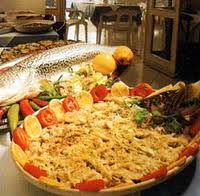Garda Lake : Gastronomy
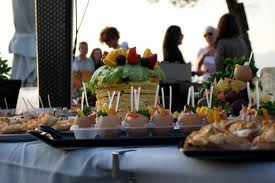
Lake Garda : Food, Wine and More
Carne Salada – Salted meat – The dishes from the Trentino area of Lake Garda is chiefly influenced by Alpine cuisine. The inland mountain area has always provided a variety of dishes made of meat, butter, cheese and mushrooms, as well as an assortment of mountain herbs and seasoning. Nearly all traditional menus feature a variety of boiled or roasted meats ranging from beef to pork, and from poultry to wild game. The cuisine was greatly influenced by the Italian and Hapsburg courts (and the Bishop’s See in Trent), which introduced their traditional dishes. The assortment is vast: dishes range from stews to goulash, from rabbit stewe to wild game served with mushrooms and polenta, from “pastelli” made of meat with sauce and “peverada”, bread cubes cooked with pepper and extra-virgin olive oil, to shish kabobs and roasted meat and potatoes. The most famous dish is carne salada [salted meat].
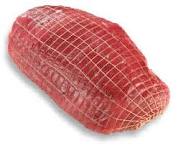
The recipe is quite simple, but it must be very carefully prepared.
Take several kilos of beef. Remove the fat and cut the beef in slices about 800 g each. Prepare a glass or ceramic jar about 15 cm tall. Place a generous amount of laurel leaves, garlic cloves, pepper corns and rock salt on the bottom of the jar. Neatly arrange the beef slices and cover with a generous amount of laurel leaves, garlic cloves, pepper corns and rock salt. Cover with a wooden carving board and place a weight on top to press the meat. Let the beef rest for about twenty days.
During this period, the aromas and salt will extract the water from the meat and season it. Make sure the infusion is homogeneous and there are no spots. Afterwards, thinly slice the beef, pound it to tenderize it and cook on a hot grill. Season the meat with extra-virgin olive oil and serve with boiled beans and pickled vegetables.
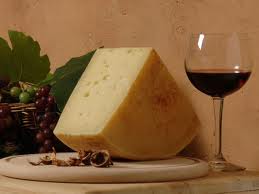
Lake Garda : Food , Wine and More
The fish and wines of lake Garda: Combinations… And something out of the ordinary – Staying on Lake Garda without enjoying its distinctive fl avours means missing an opportunity to discover everything the area has to offer, and making any length of stay that little bit more special. The pleasure of visiting new places is combined with that of sitting down at a table to enjoy fresh summer dishes, where fish from the lake reins supreme. Restaurateurs are becoming increasingly aware that they are surrounded (for the time being at least) by an abundance of varieties of fish, some unique, such as the unequalled salmon carp, and traditional recipes to reinvent and repropose. They have reopened a chapter that seemed closed and now offer fish menus so intriguing and inviting as to make your mouth water just to read them. It is also an exciting part of the holiday to rise with the birds and stroll down to the harbour to await the return of the handful of professional fishermen still in existence and grab the best of the freshlycaught fish for dinner with family and friends. It could trout or whitefish, sardine or pike, perch or eel, tench, carp or chub, burbot or barbel, a rare salmon carp or even rarer alborella (Alburnus alborella). All should be cooked as simply as possible, to enhance the quality and features of the fish and with delicate fl avouring – a sprinkling of parsley, a light sauce, or a little garlic and extravirgin olive oil from the lake. A delicious result is guaranteed. Trout and whitefish can be cooked in a variety of ways, but are best grilled; pike prefers to be boiled; perch should be filleted and fried in butte;, tench can be stewed or baked or put in a risotto; chub is delicious fried in slices or grilled, and the same goes for sardines. And aole (a kind of sardine) – if you are lucky enough to find any – are superb as an appetizer, fried, and the elusive salmon carp is exquisite both boiled and grilled. What matters most is that the fish is really fresh. So if you have not yet befriended a fisherman, here are two addresses where you can’t go wrong: La Pescheria fishmongers (8, Via Antiche Mura, tel. 045 6270545) in Garda, which belongs to the Fishermen’s Cooperative and also sells processed or smoked fish and even tortellini with delicious fish filling, and Pescheria Cavallaro (19, Via Stretta Castello, tel. 030 9142495) in Desenzano.
For those who prefer to sit down in comfort and be served freshlycooked fish, a safe bet is Osteria al Pescatore in Castelletto di Brenzone (31, Via imbarcadero, tel. 045 7430702) where friendly hosts Livio and Rosaria will treat you to one of their specialities taken from their recipe book Il Garda in Pentola. Whatever the recipe, however, the accompanying wine is all important. While it is true that fish lives in the water, it likes to be served with a good, if not excellent, locallymade wine. And while white is the usual choice, no less suitable is a fine chiaretto. Even a tasty young red wine, served at the right temperature, is a good accompaniment for fish stewed in a spicy hot sauce. And anyone gifted with good sense – and a vivid imagination – can come up with something truly out of the ordinary.
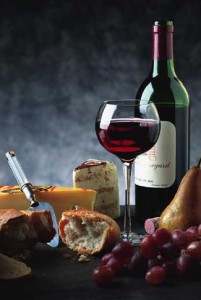
Fried fillet of perch
Ingredients: one 250g perch per person, extravirgin olive oil, plain fl our, salt (and one egg and breadcrumbs if desired).
This easy traditional recipe takes ten minutes to prepare and five to cook.
Fillet the fish, coat the fillets lightly in fl our and fry in boiling olive oil until golden brown on both sides.
Sprinkle with salt and serve hot.
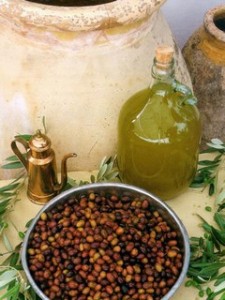
Sardines with oil, parsley and garlic sauce
Ingredients: twelve sardines, a little chopped parsley, one clove of garlic, one lemon, one small glass of extravirgin olive oil.
This easy recipe takes ten minutes to prepare and ten minutes to cook.
Grill the sardines. Meanwhile, mix the chopped parsley and garlic, lemon juice and oil in a bowl.
Open up the fish, remove the bones and arrange on a serving dish.
Sprinkle with salt and pour over the sauce.
Excellent as a starter.
Lake Garda : Food, Wine and More
“Consorzio di tutela del Bardolino”, the Bardolino wine consortium, has designed an itinerary that runs through its production area. The Bardolino wine route starts in Bardolino, where you should stop to see the Romanesque San Severo Church with its early 12th century frescoes (there is also a semicircular crypt from an earlier church built on that site and mentioned in documents from the 9th century). Another masterpiece – the San Zeno church from the 9th century – is just a few hundred meters away.
The route climbs the hills, passing the ancient San Colombano monastery, to reach the Cortelline hamlet with its Romanesque San Vito church.
Further ahead is the road leading to the Rocca Camaldolese hermitage (the church contains paintings by Palma il Giovane and Paglia).
The itinerary proceeds to Costermano (a detour takes you to the large German war cemetery and then to the hamlets of Castion, with the beautiful Pellegrini villa, and Marciaga, with the small sanctuary dedicated to the Madonna del Soccorso) and reaches the hamlet of Albarè and, shortly thereafter, Affi, which sits below Mount Moscal (see the splendid Da Persico Villa, now the home of the Poggi family, and the Elena Da Persico villa).
Beyond the Caorsa district is Cavaion Veronese, where you can see the most ancient history of the area if you visit the small archeological museum in the town hall (the rooms mainly display prehistoric finds from the nearby Cà Nova lake).
To the left of the San Giovanni Battista parish church, which overlooks the town, is a road that takes you to the hamlet of Incaffi (the villa owned by famous physician-scholar Girolamo Fracastoro is nearby).
The itinerary continues, heading to Pastrengo (famous for the battle of April 30, 1848 that involved 300 carabinieri on horseback from King Carlo Alberto’s guards), then Sandrà, Castelnuovo del Garda, Pacengo and Colà.
It reaches Lazise, whose old town center is surrounded by Scaliger walls.
The Romanesque San Nicolò church and the Venetian customs building face the Lazise port, and the elegant and imposing Scaliger castle is a short distance away.
On your way back to Bardolino, you’ll pass through Cisano, where you can admire the Santa Maria parish church.
That extra reason for staying on Lake Garda, in among the olive, beech and chestnut trees.
When Mother Nature resolved to create Lake Garda, she certainly did not skimp on her energy, and drew from her palette all the colours of the rainbow. And she spread them plentifully over the hills and mountains. She distributed them in the bright shades of blue of the water, in the thousand hues of the luxuriant vegetation. Each and every season has its own fascinating colour chart to display before our eyes, filling us with ever new emotions and sensations.
Autumn and winter reserve an amazing spectacle of lights and colours, smells and tastes; they are lavish with fruits, flowers and herbs, to the delight of excursionists and botanists, artists of the brush and the lens, gourmets and philosophers, hedonists, lovers of the good and the beautiful.
Mountainous rivieras on the Brescia, Trent and Verona sides of the lake, wild and secluded, oases of unspoilt nature where numerous animals have found their ideal habitat, in the woods of beech, hornbeam and fir, lying midway between uplands and meadows, and the deep valleys that form a backdrop for little hamlets, farmhouses and mountain huts.
These are the woods of Valvestino and the plateau of Tignale and Tremosine on the Brescian Riviera, with their colours and reflections.
The colours and lights of Verona’s mountains, of Mt. Baldo, dubbed the garden of Europe, and often carpeted in snow in winter time.
And on the lower slopes of the mountain, a panoramic balcony like no other, lies the little town of San Zeno di Montagna.
Home to around 1,800 inhabitants, offers views up and down the lake, from the Sirmione peninsula right up to Riva del Garda at the far end.
It is a privilege to be able to observe the views and sunsets, as well as a series of images from the morainic hills in the south to the olive groves and the peaks of the Lombardy and Trentino preAlps to the north.
Behind the village are the peaks of Mt.Baldo, with their pastures, forests, chestnut woods and a rich variety of unique botanical species.
The village itself lies on a plateau that extends for several kilometres at an average height of 600 metres above the lake, dotted with tiny ancient hamlets, each with an identity of its own.
The point of reference is the district of San Zeno, with the parish church and the square of the same name where a local market is held every Monday.
Just round the corner are Ca’ Schena, Ca’ Sartori and the quarter called Ca’ Montagna, with its 15th century town hall, library and Forestry Service.
Then come Castello and recentlyrebuilt Laguna, followed – on the road down to Brenzone – by Borno and Villanuova.
If you take the road up right from the fork, you encounter Pora, Baitei and Corrubio, rural hamlets surrounded by farmed fields, pastures, and ageold chestnut woods which produce the renowned San Zeno nuts called marroni, which boast the protected designation of origin.
At Corrubio the road divides: left to Prada, passing through Pra Bestemà, a lovely spot with the longest meadow terrace on Mt. Baldo and magnificent views; to the right the road flattens out and passes through Ca’ Longa on its way to Lumini, where it turns back towards the centre of the village, via the pinewood.
It is a lovely route with lots to see and the opportunity to try some local specialities in one of the local restaurants or agriturismo farms – hams and cheese, of course, but also produce from the woods, including chestnuts, and from the underwood, such as mushrooms and truffles, not to mention honey, as well as aromatic and medicinal herbs used to make herbal teas and infusions.
One of the best loved regional specialities is chestnut soup, made from an ancient traditional mountain recipe.
San Zeno di Montagna is the ideal location for a variety of sports, especially mountain biking and trekking.
The mild, relaxing climate encourages visitors to explore hidden corners of the various quarters, follow the easy, shady paths that crisscross the mountainside, and the more adventurous to climb to the summit of Mt Baldo.
At Prada, skilifts whisk you up to an altitude of 1,850 metres, from where you can ascend to the highest peaks, Cima Val Dritta (2,218 m) and Cima Telegrafo (2,200 m), where an alpine refuge operates in summer.
A keepfit trail and a Jungle Adventure park in Pineta Sperane offer an exciting alternative for adults and children alike.


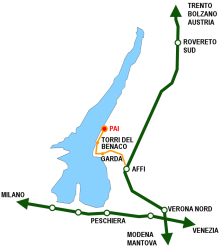






 Updating...
Updating...